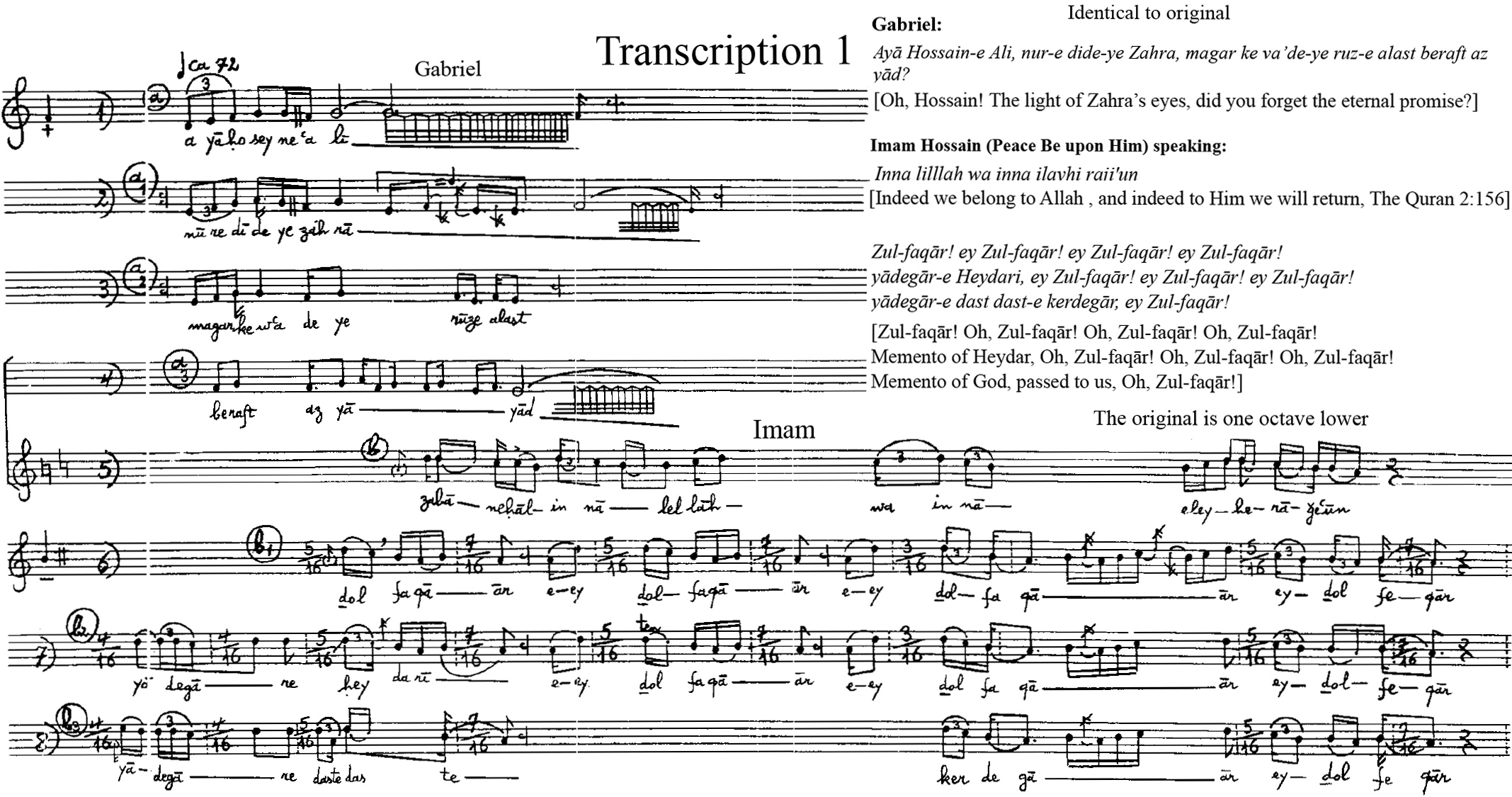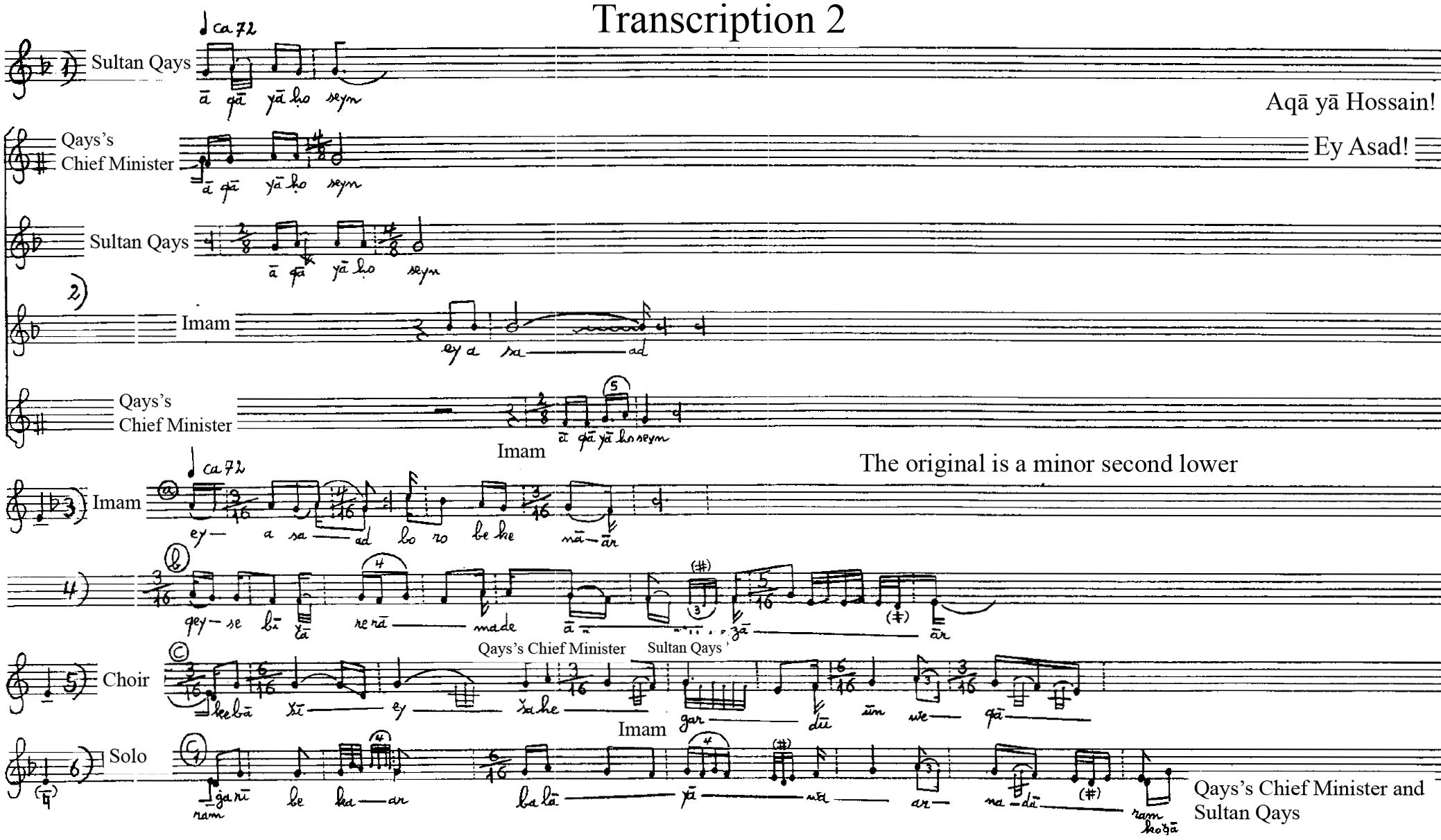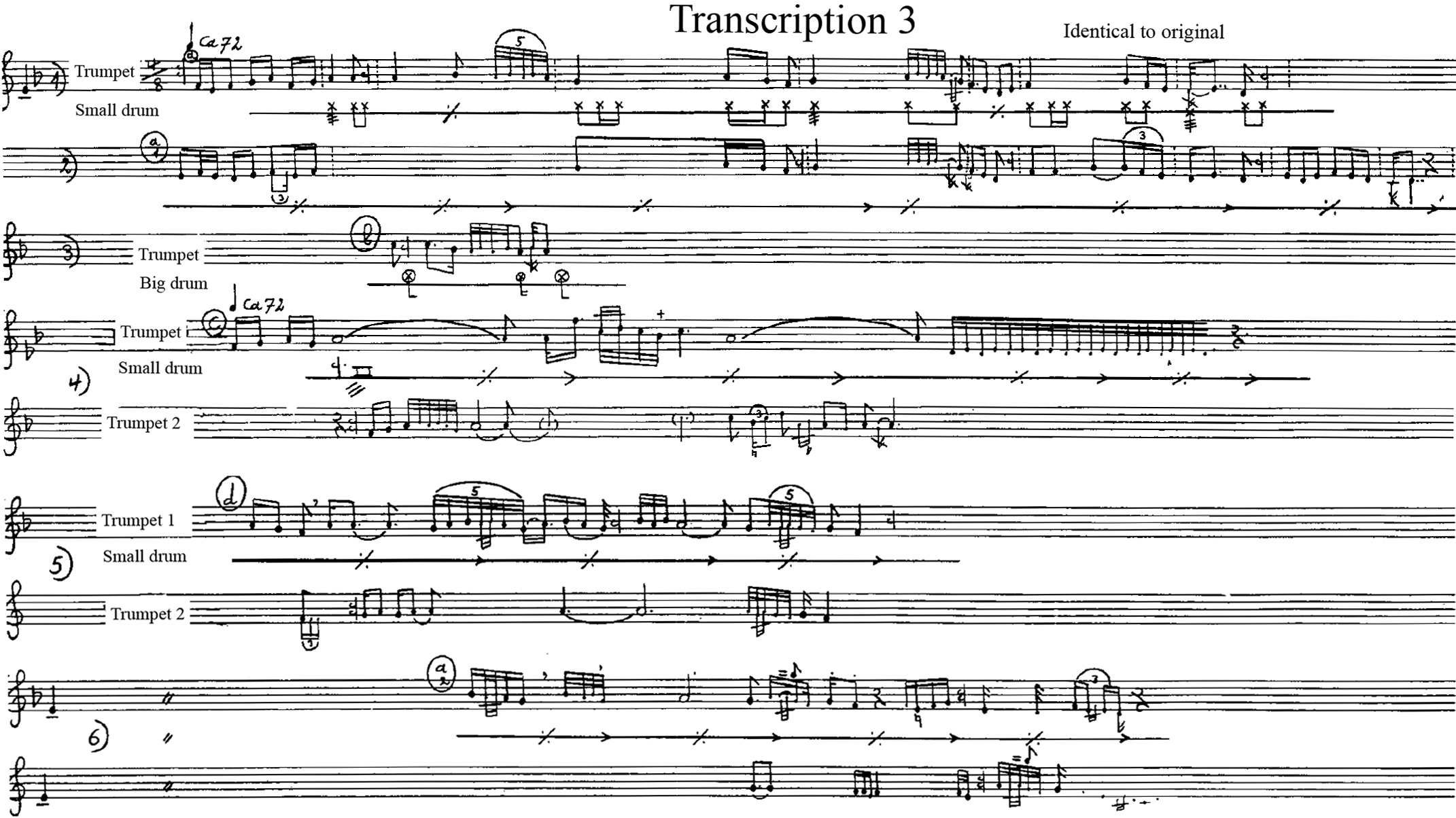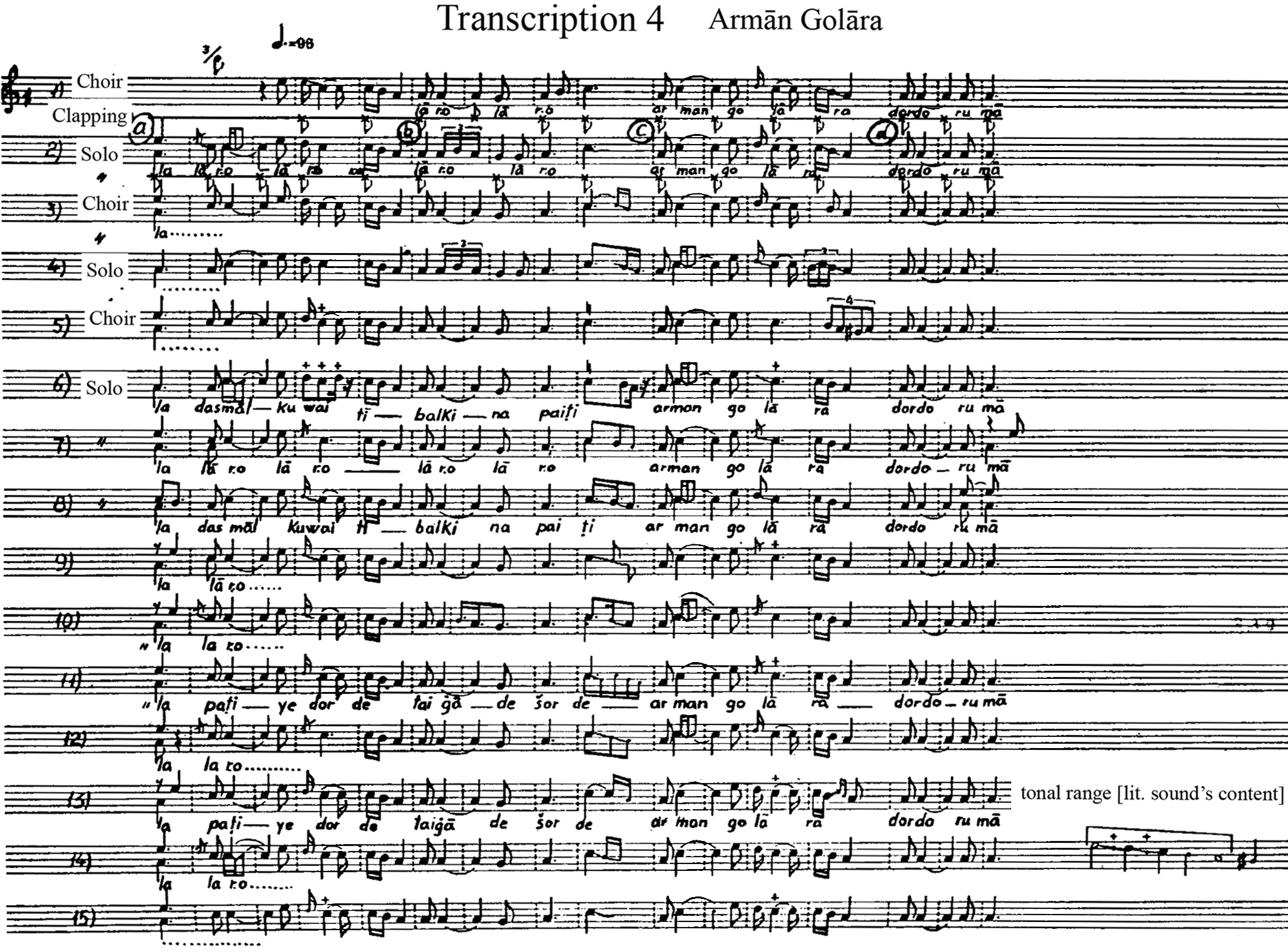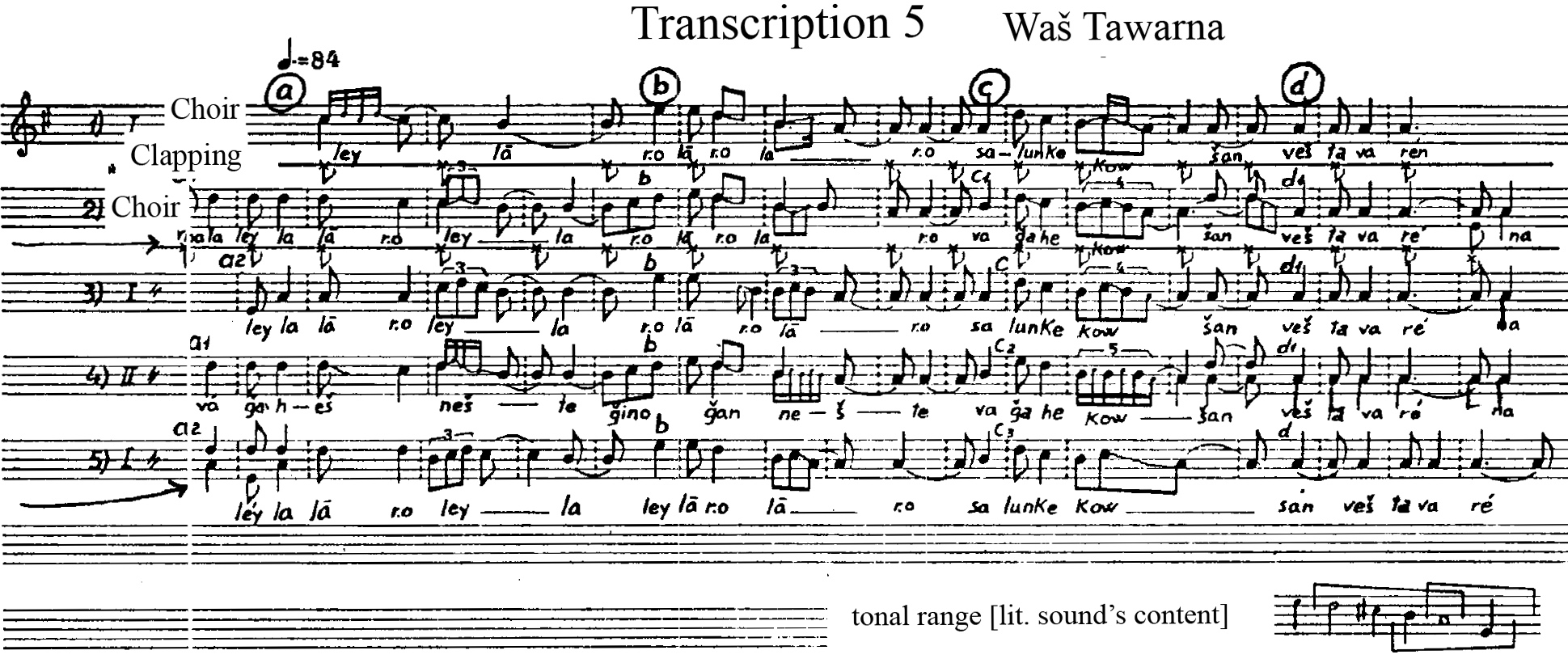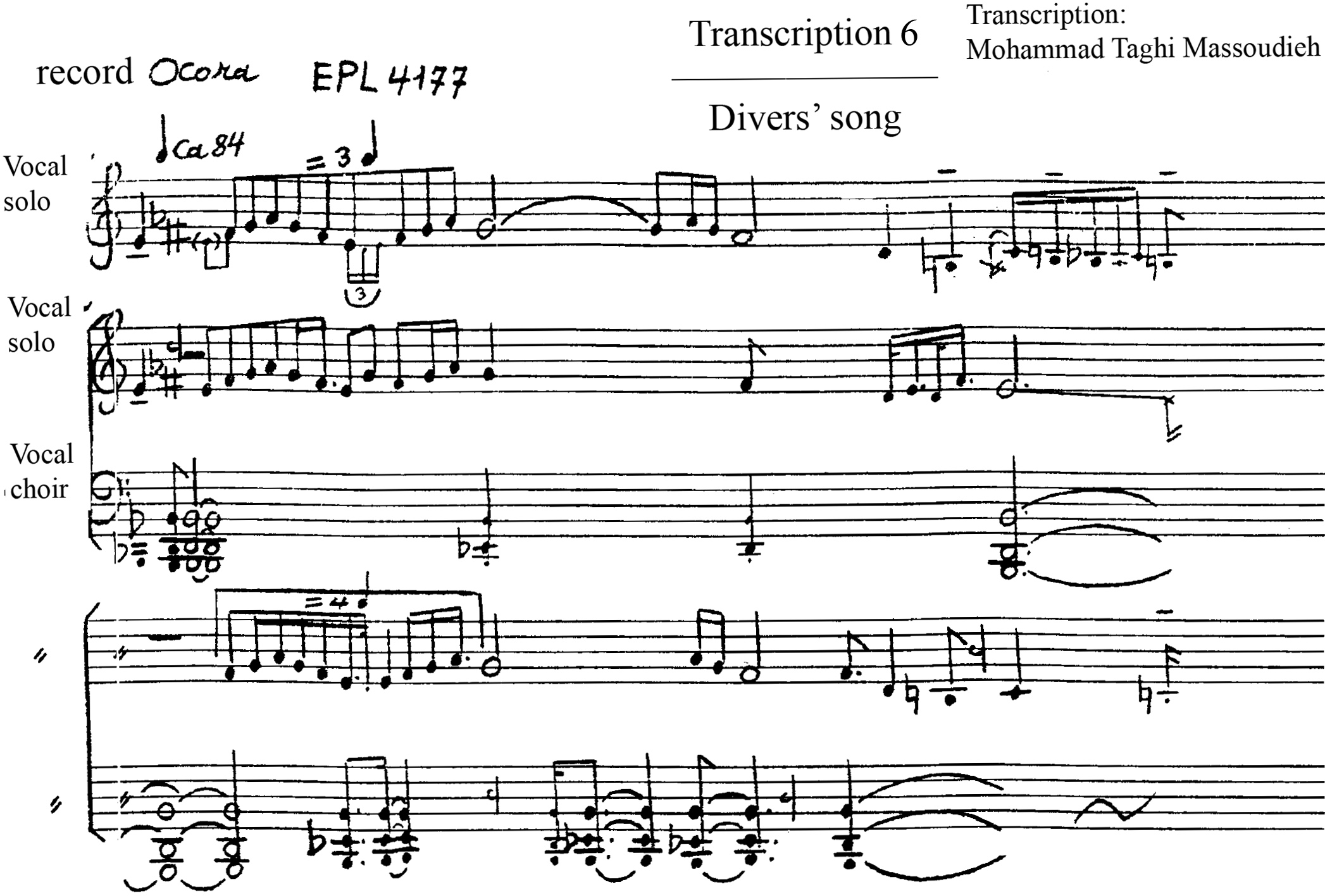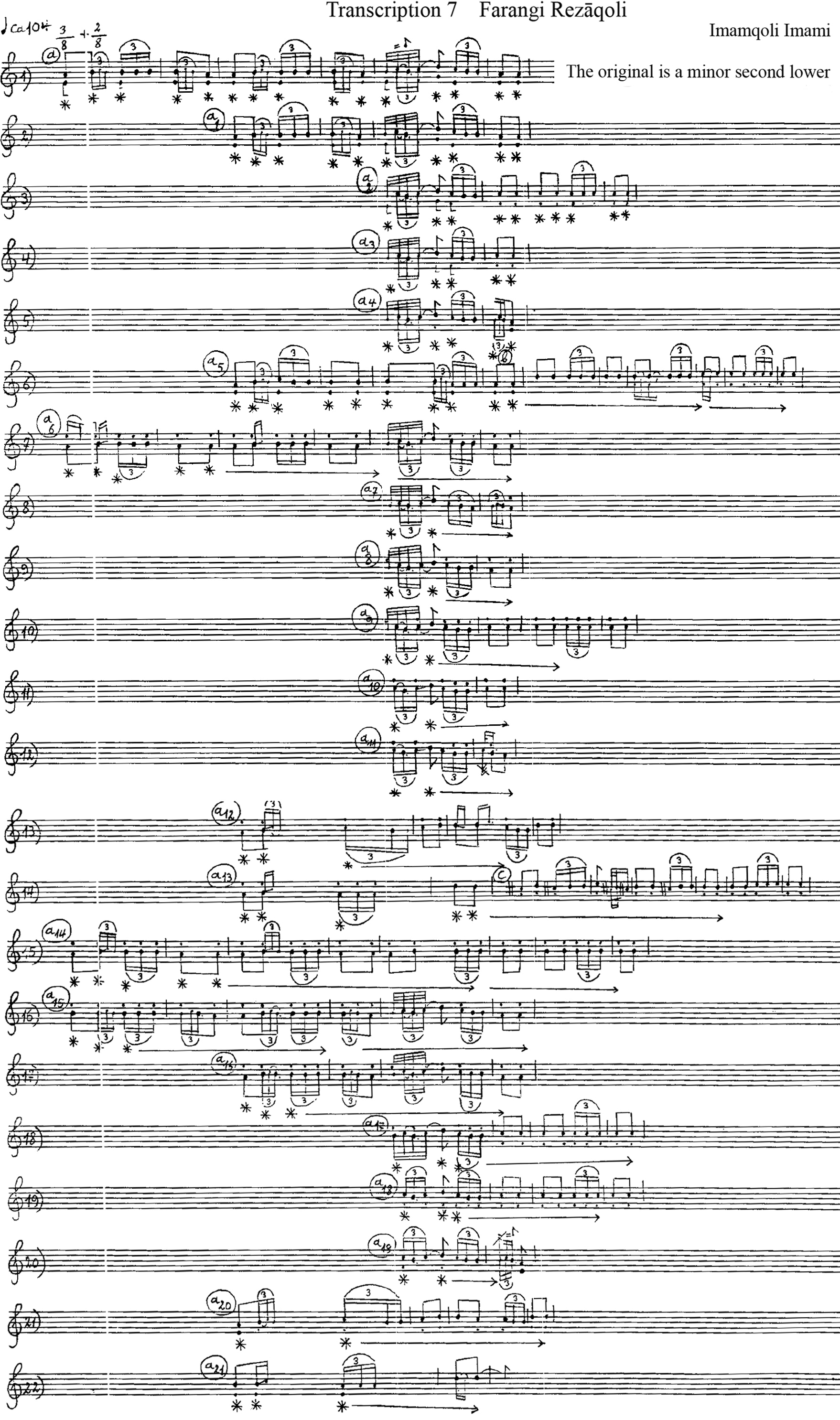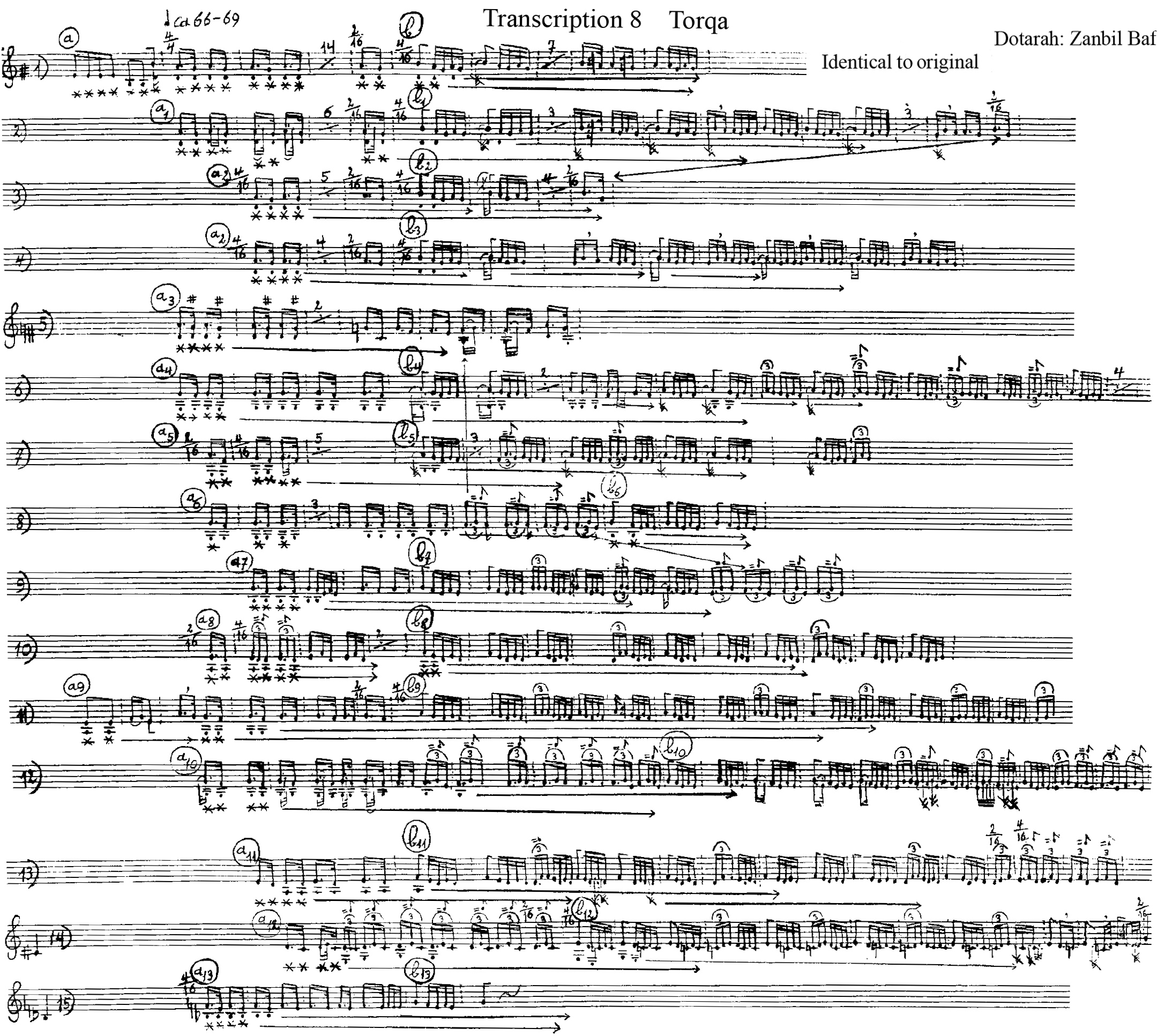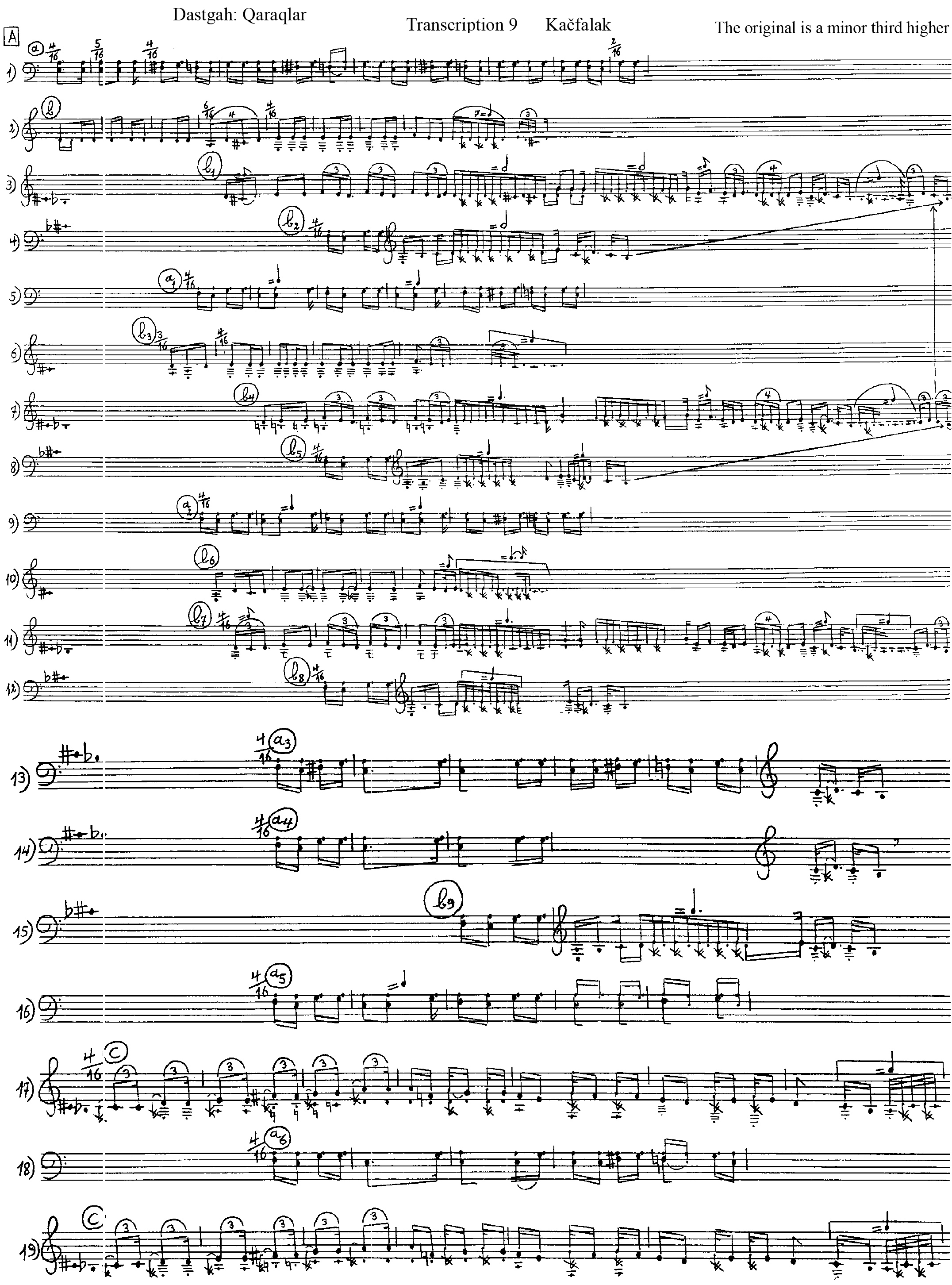|
Polyphony in Iranian Music
Mohammad Taghi Massoudieh Originally published as “Čand Sedā-i dar Musiqi-ye Iran (چند صدایی در موسیقی ایران).“ Honarhāye Zibā 3, 1998, 95-104. Draft translation: Abdolmohammad Movahhed, copy-editing: Jessica Sloan-Leitner, with advice on transliteration by Babak Nikzat. Abstract Although Iranian regional music, like Iranian traditional[*] music, is basically monophonic and follows the rules of heterophony, we occasionally run across polyphonic pieces, although most have been unwittingly formed as such. This study shows that these polyphonic pieces could be found in the following forms:
1. The meeting of two vocal parts, where the second singer starts singing before the melody is completed by the first.
The radif of traditional music and the Iranian regional music, like those of other Middle East countries, is monophonic and follows the forms of heterophony; that is, the same melody is played and changed by two or more players. The change of a specific melody by two players, or a player and a singer, sometimes leads to the simultaneous playing of two different notes. Such an interference or combination of two sounds is a matter of heterophony, and by no means of harmony or accord. Interference of notes or combinations of notes in heterophony are not predictable. Since the melody is played extempore, the aforementioned combinations happen accidentally and thus cannot exemplify polyphony.[1] Even though Iranian regional and traditional music are predominantly heterophonic, we come across instances of mostly unwittingly created polyphony.
The various forms of polyphony in Iranian music discussed in this article are introduced as a result of my research on Iranian music, especially that of Iranian regional music of various districts. Almost all of the following transcriptions have been already published in my previous publications. Here I will analyze one example for the study of each form of polyphony. The forms of polyphony [in Iranian music] will be discussed below.
Transcription 1 concerns the ta’ziye of “The Martyrdom of the 72 People,” which I recorded in Dehabad of Meybod (near the city of Yazd) on September 14, 1980.[2]
The song of Imam Hossain (Transcription 1, b, staff 5) starts before the melody of Gabriel (a3, staff 4) ends. The song of Imam Hossain takes a definite meter from staff 6 onward (Transcription 1), which consists of an irregular succession of asymmetric metric-rhythmic units of
As explained earlier, delay in the alternate play of the melody by Sultan Qays, his chief minister and Imam Hossain leads to the formation of an imitation or canon (Transcription 2, staff 2). The ending half-line of the sultan and his chief solely consists of the repetition of “aqa, ya Hossain!” staff 2). When Imam sings the half-line beginning with “ey Asad!” the words cross the abovementioned repetition, which together make for the formation of an imitation or canon. The announcement-like litany of “yā Hossain!” is repeated by a single voice (Transcription 2, staff 2).
The ta’ziye of “Imam Hossain’s Martyrdom” ends with a performance of two trumpets accompanied by a small and a big drum (Transcription 3).[4] The crossing of the notes due to the changes made to the same melody by the first and second trumpets is clearly shown in staffs 5 and 6 (Transcription 3). The second trumpet plays the first trumpet’s part with a delay and makes a little change to it. Thus the notes resulting from the variant heterophony cross each other (Transcription 3, d, staff 5; a2, staff 6). Polyphonic forms are found not only in ta’ziye but also in Iranian regional music. In the Iranian region of Baluchistan there is a special wedding song called “Lāru,” usually sung after the bridegroom’s bath and return to his special seat.
“Lāru” is also performed on the sixth night into the pregnancy and is thus also named “sheshgani.” The song is called “Lāru” since it has a refrain consisting of nonsense syllables “lāru li, lāru, lāru.”
Transcription 4 (Armān Golāra): Translation of the lyrics: “lāru, lāru, lāru! Armān Golāra! Take off your cover, the Kuwaiti one! Maybe, he doesn’t want that. Take off your headscarf!”1[***]
The song of Armān Golāra is exchanged between a soloist singer and a chorus in a responsorial form; as a result, two different voices meet at the fifth and third (Transcription 4, staffs 2, 5, 7) because the chorus starts singing the next part before the soloist completes his part. Each part of the song is composed of a period consisting of four melodic figures (staff 2, a + b + c + d).
Of these, the first and third figures (a and c) are to some extent similar, while the second figure (b) seems to be in contrast to the rest. The last figure (d) consists of the repetition of the ending A note.
Transcription 5 (Waš Tawarna): Translation of the lyrics: “li lāru, lāru! The bridegroom’s shoes make a good sound. The man’s shoes make a good sound. The man is sitting for a perfect life. The man is sitting.[5] The song of Wash Tawarna (Transcription 5) is alternately performed by two choruses in the shape of an antiphoner. Before the first chorus finishes its part, the second chorus starts singing the same part, resulting in the crossing of two different voices (Transcription 5, staffs 2 and 5). Here, too, each period consists of four melodic figures (Transcription 5, staff 1, a + b + c + d) and the last figure (staff 1, d) is only a repetition of the ending A note. With regard to the above two songs (Transcriptions 4 and 5, Armān Golāra and Waš Tawarna), it would be helpful to point out two theories concerning the evolution of polyphonic forms. The first theory is that of Fritz Bose,[6] who argues that polyphonic forms have followed three old routes in the alternation of songs between the singer and the chorus. The three forms are as follows: 1. The chorus repeats the whole part vocalized by the soloist singer. 2. The chorus repeats the refrain only. 3. Half of the part is sung by the soloist singer while the other half is performed by the chorus. The interference of sounds in these old forms of alternation has led to the evolution of polyphonic forms. The drone and even ostinato are advanced shapes of these old forms. The second theory comes from Marius Schneider,[7] who takes the perfection of polyphonic music to be a result of heterophonic changes appearing in the performance of melodies by a few singers, a theory which is not supported nowadays. There are also other theories regarding the appearance of polyphonic music.[8]
For the drone, the Bahraini divers’ song will be discussed here since it seems to be partly connected to the music of south Iran. The diving season in Bahrain is divided into two periods: “ġows ul-kabir” and “ġows ul-bard”. The former period [roughly] covers mid-May to mid-November and the latter covers the previous months. The fishermen consist of the captain, the divers, the divers’ helpers and naham [i.e., the encouragers].[9]
Transcription 6: The naham (Transcription 6, staffs 1-3), with their song, accompany the divers when they are deep down in the sea. This song is followed by that of the helpers who accompany the naham’s song in a drone form. This drone-like chorus part (staffs 2 and 3) is composed of the three bass notes of Bb, D and Bb. The second note of D moves towards Eb and returns to D. The movement towards Eb and return to D is performed along with the naham’s production of long G and F (staffs 1 and 2). In addition to the forms mentioned above, polyphony is also created when the same melody is performed by a few singers, each performing the melody using their own voice register and based on their own physiological capabilities. An example of such polyphony can be found in Mahabad’s Qāderi dervishes’ religious ritual ceremony held in their monastery which includes singing and dancing.[10] The continuous repetition of a melody or motif, which is comparable to hypnosis, leads to the monotony of the dancing movements and ultimately results in a state of trance. Thus, the trance is a metaphysical state, a borderline condition between life and death.[11] It is perhaps for this reason that in the ceremonies performed in Sanandaj’s Qāderia monastery, such extraordinary and excruciating acts such as inserting razors or daggers into their bodies are considered as pleasing activities. Thus, the trance consists in complete unconsciousness, so much so that the dancer falls down lifeless at the end, and his return to the material world is accompanied with screaming.[12]
The polyphonic forms introduced above are not created deliberately, contrary to other forms of polyphony in Iranian music which are produced wittingly. The deliberately created forms are often performed by instruments, usually dotars. I will try to introduce a selection of such forms below.
Transcription 7 (Farangi Rezāqoli): Farangi Rezāqoli is a common maqām in the province of Lorestan (Transcription 6). The word “Farangi” denotes that the melody has been adapted from a foreign source, and the name “Rezāqoli” refers to the person who has adapted the melody, or to the person from whom the melody has been acquired.[13] In Lorestan, a dotār is called a tamira. Farangi Rezāqoli (Transcription 7) has been performed by Imāmqoli Imāmi, the famous tamira player of Lorestan. The melodic figures of the Farangi Rezāqoli maqām are accompanied by a second voice like a drone. The drone continuously follows the up-going or down-going movement of the melody. The movement of the drone in this way produces a sort of parallelism or a sequence of two notes. The maqām of Farangi Rezāqoli consists of three melodic figures (Transcription 7, staffs 1, 6, 14, a + b + c). Of these, the first figure (a) changes most. The succession of two voices due to the drone’s following of the movement of the melody or the movement of the drone is similarly found in other maqāms of Lorestan, including "Farangi Khān Mirzā,” “Māla Žeyri” and “Āwāzand Be Puva Muri.” I have restricted myself to one example here.
The crossing of two voices in a parallel way due to the movement of the drone is also seen in the instrumental pieces of Khorasan and Turkman. Two examples will be given here: one is “Torqa” of north and northwest Khorasan and the other is “Kačfalak” of Turkman music.
Transcription 8 (Torqa): “Torqa” is another name for the bird “Jal.” In other words, the maqām of Jal, which is common to Esfarayen and Bojnurd, is called Torqa. This maqām, which was previously played by Bakhshis, is now rarely performed. The maqām of Torqa describes the flight of the torqa in the sky. The bird flies so high in the sky that it goes out of sight but then returns and sits on the ground. The torqa once again repeats the high flight, and this variety of flight is described in music. The maqām of Torqa (Transcription 8) has been performed by famous Zanbil Bāf Bakhshi. The melody of Torqa is composed of repetitions of a cliché melodic figure which is moved into various tonalities. This modulation is accompanied by a change of the drone. When the drone moves along with the melodic figure in different tonalities, two [different] notes are played in a parallel way. The maqām of Torqa, due to its metric-rhythmic symmetry, enjoys a motor movement. The frequent repetition of the cliché melodic figure, together with the metric-rhythmic symmetry, describes the monotony of the torqa's flight.[14]
This type of polyphonic instrumental form is also very common in Turkman music. I will explain one melody titled “Kačfalak” here.
Transcription 9 (Kačfalak): Melodies in the maqām of Kačfalak, as the name suggests, express the sorrow of an evil fate and are thus preformed in the dastgāh of “Qaraqlar.” In Turkman music, maqāms which have a sad tone or describe sorrowful conditions are performed in this dastgāh.[15] The maqām of Kačfalak (Transcription 9) has been played with a “tamderā,” the Turkman name for a dotār. The beginning figure (Transcription 9, staff 1, a), as an intermediary part, appears throughout the piece in the form of melodic periods. The period types of staff 2 (b) have either a definite meter or a free meter, or else start with a definite meter and end in a free meter. Almost all of these types continuously end in a short cliché figure (staffs 3, 4, 7, 8, 11-15). In Kačfalak (Transcription 9), as in the transcription of Farangi Rezāqoli maqām (Transcription 7), the second accompanying voice always follows in the direction of the melody’s movement and leads to the succession of two voices in a parallel form. Apart from the examples given above, there are other forms of polyphony in Turkman music which consist of a succession or change of two combinations of notes. A succession or change of sounds is usually performed at the beginning of the parts and is generally dependent on the change of the drone. Such a change is definitely not based on a harmonic sequence or a sequence of chords. Another common form of polyphony in Turkman music is an ostinato. Usually the figure which appears in the form of an ostinato in the piece is introduced individually at the beginning.[16]
The polyphonic forms of Iranian music discussed here were described on the basis of a selection of the most distinguished Iranian melodies. These forms are also found in many other instrumental and non-instrumental melodies of Iranian music. Obviously, further recordings could provide us with other conclusions regarding Iranian polyphonic music or the presence of other polyphonic forms in Iranian music.
|
